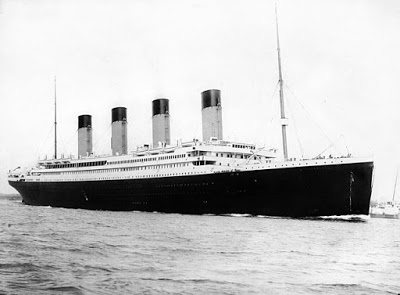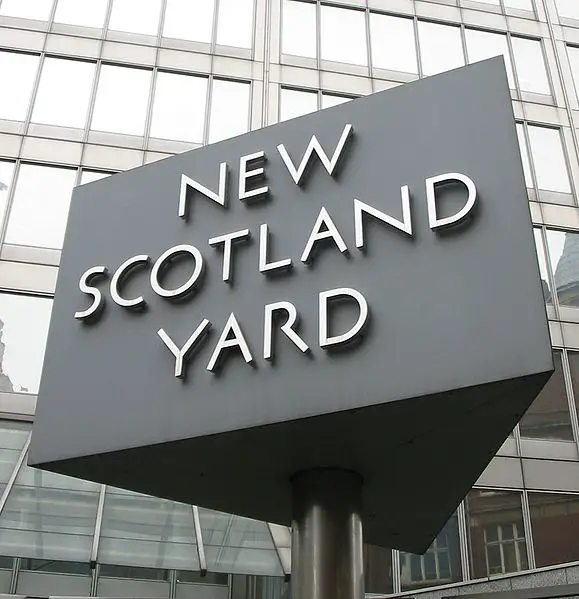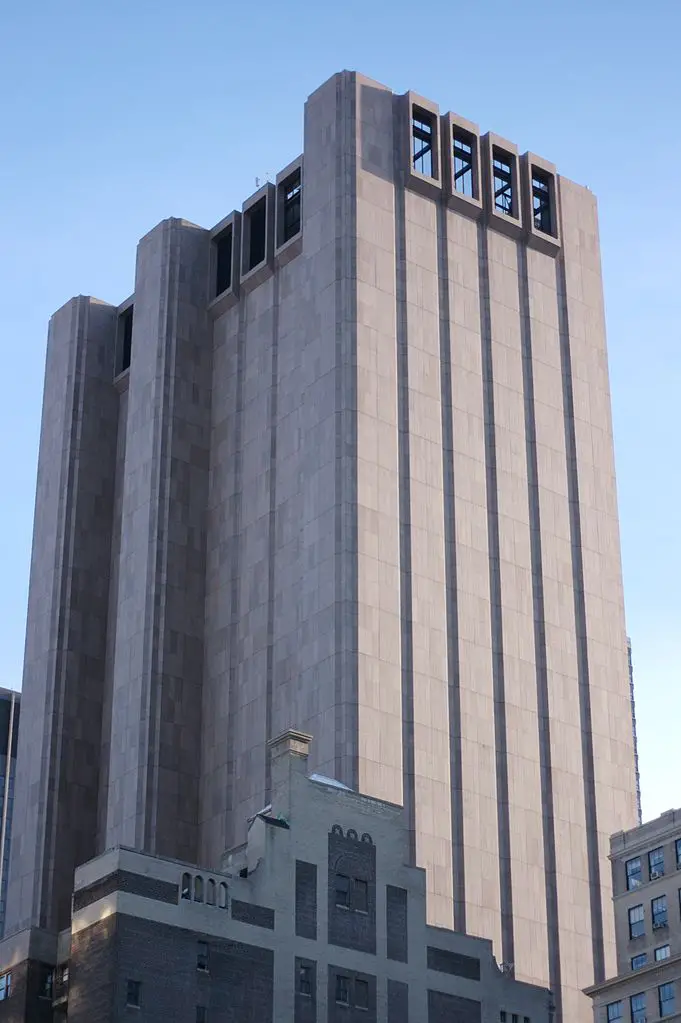
The weekly collection of random and fun facts. In this week’s edition: The Widest Avenue, A Popcorn Giant, The Titanic Posing, An Unsolved Scotland Yard Mystery, and a Skyscraper Not Built for Looking Out a Window.
 |
| jmpznz/Wikimedia |
Take care crossing this street. It may take you a long time. The widest avenue in the world is 9 de Julio Avenue (9th of July Avenue) in Buenos Aires, Argentina. It has 14 lanes total, 7 in each direction, and 2 parallel streets on either side. It’s not completely covered with pavement over its entire width and has green areas in-between the traffic that flows in opposite directions. The width of the avenue is about 360 feet, a little more than the length of a football field. The beginning phase of the street began in 1937, but the idea had been planned since 1888. Construction wasn’t completed until the 1960s and further sections running south were completed in the 1980s. It’s named for Argentina’s Independence Day of July 9, 1816.
There is some debate whether 9 de Julio is truly the widest avenue in the world. The Guinness Book of World Records had recognized it as the widest but took away the honor in 2006 when it declared the Monumental Axis in Brasilia, Brazil as the champion. That street is about 820 feet wide, or almost 275 yards. There are some distinct differences between the two however. Monumental Axis has two six lane highways which are cut in two by a very large, central park. It may be argued that Monumental Axis is not a true “avenue”, which is defined as a “broad road in a town or city, typically having trees at regular intervals along its sides.” Either way, these are some really wide roads. Source, Source
 In 1970, Orville Redenbacher hired a firm and paid them $13,000 to come up with a name for his popcorn company, which was then called Red Bow. Their suggestion? Name the company Orville Redenbacher. The firm also suggested that he should put his own face on the label. Redenbacher often joked that his mother had dreamed up the name for free.
In 1970, Orville Redenbacher hired a firm and paid them $13,000 to come up with a name for his popcorn company, which was then called Red Bow. Their suggestion? Name the company Orville Redenbacher. The firm also suggested that he should put his own face on the label. Redenbacher often joked that his mother had dreamed up the name for free.
Orville Redenbacher was an agricultural scientist, and he, along with his partner, Charlie Bowman, came up with a breakthrough for the improvement of popcorn. Their big achievement took place in 1965 when Redenbacher and Bowman introduced the “snowflake” variety of popcorn. In relation to the popcorn that had been made for over 5,000 years and introduced by the Iroquois Indians, the Redenbacher/Bowman popcorn expanded up to 40 times more than their original size. The common variety popcorn of the time expanded 20 times their size.
While the popcorn was nice and fluffy, it was costly to make the variety. No one wanted to try to take it on as a product so Redenbacher began trying to sell it to retailers in Indiana himself. He didn’t have any trouble selling his Red Bow popcorn. That was where the meeting with the firm that convinced him to change his product’s name happened. In five years after it was introduced with its new name, Orville Redenbacher’s Gourmet Popping Corn became the leading popcorn product in the country. In 1976, the pair sold the brand to Hunt-Wesson, and Redenbacher became a company spokesman. Orville Redenbacher Popcorn continues to be the number one popcorn brand in the United States. Source
 The fourth funnel at the stern of the Titanic was a fake. It was added to make the ship appear more powerful and symmetrical, but they did have a particular function. The funnel carried vents from the engine room and also carried vents that came from the coal stoves that were in the main kitchen of the ship. Source
The fourth funnel at the stern of the Titanic was a fake. It was added to make the ship appear more powerful and symmetrical, but they did have a particular function. The funnel carried vents from the engine room and also carried vents that came from the coal stoves that were in the main kitchen of the ship. Source Scotland Yard, considered one of the world’s most renowned police agencies, was built on the site of an unsolved murder in 1888 called the Whitehall Mystery. The mystery started during construction of the Metropolitan Police ‘s new headquarters that was near Whitehall in Westminster. A worker on the site found human remains in a vault in a cellar that was only three-months old. On September 29, 1888, a worker had secured the vault and had been the last one inside. It was determined that between that time and October 2, 1888, someone had been in the vault to stash the remains. The unknown body had been wrapped in black cloth and tied.
Scotland Yard, considered one of the world’s most renowned police agencies, was built on the site of an unsolved murder in 1888 called the Whitehall Mystery. The mystery started during construction of the Metropolitan Police ‘s new headquarters that was near Whitehall in Westminster. A worker on the site found human remains in a vault in a cellar that was only three-months old. On September 29, 1888, a worker had secured the vault and had been the last one inside. It was determined that between that time and October 2, 1888, someone had been in the vault to stash the remains. The unknown body had been wrapped in black cloth and tied.
The torso that was found in the vault was matched to a right shoulder and arm that had been discovered on the shore of the River Thames on September 11th. The body part found there had initially been reported as a medical school prank. There was also suggestions that it was linked to Jack the Ripper, as these killings were happening at the same time. The coroner of Westminster, John Troutbeck, examined the remains. He found that it was a woman of approximately 24-years, overall healthy, and no cause of death was able to be determined. The woman’s uterus had been removed along with her right arm. It was determined that it had been done by someone with knowledge of the anatomy of the human body since the arm had been tied with a tourniquet which reduced the blood loss. It was also determined that these things had been removed after the woman had died. It was estimated that she had been dead for six weeks to two months. The Metropolitan Police Headquarters where the mystery started eventually became known as Scotland Yard. Source
 There is a curious skyscraper in New York city that has no windows of any kind. It is known as the AT&T Long Lines Building. What is this particular building used for? Well, to answer that you have to go back to when it was constructed. It was built in 1928 by AT&T and Western Union to bring telephone service to Manhattan. The Long Lines Building was actually one of two buildings that were built during this time. The other was the Western Union building. Inside the buildings were vast telephone switching areas. Their scope was so great that the buildings had dormitories to house the workers who had to manually connect one call to another.
There is a curious skyscraper in New York city that has no windows of any kind. It is known as the AT&T Long Lines Building. What is this particular building used for? Well, to answer that you have to go back to when it was constructed. It was built in 1928 by AT&T and Western Union to bring telephone service to Manhattan. The Long Lines Building was actually one of two buildings that were built during this time. The other was the Western Union building. Inside the buildings were vast telephone switching areas. Their scope was so great that the buildings had dormitories to house the workers who had to manually connect one call to another.
It isn’t really that different today, other than the huge leap in technology and the absence of dormitories. It still acts as switch point, but it’s a switch point for the internet. It’s one of the largest internet switch points and is home to some of the world’s largest websites. The security has even changed since the time of the telephone switching that had been done there. It’s a highly secure area with biometric security, which is identification using human characteristics such as fingerprints, voice, or retinal scans. The building is also the home to over 400 telecom carriers which operate over 600 data networks. It becomes apparent that the building has no need for windows. Source
Another edition is done. That went by way too fast. Check back again next time. Now, don’t you feel smarter?
Need more random facts? Check out more from the Random Facts of the Week.


